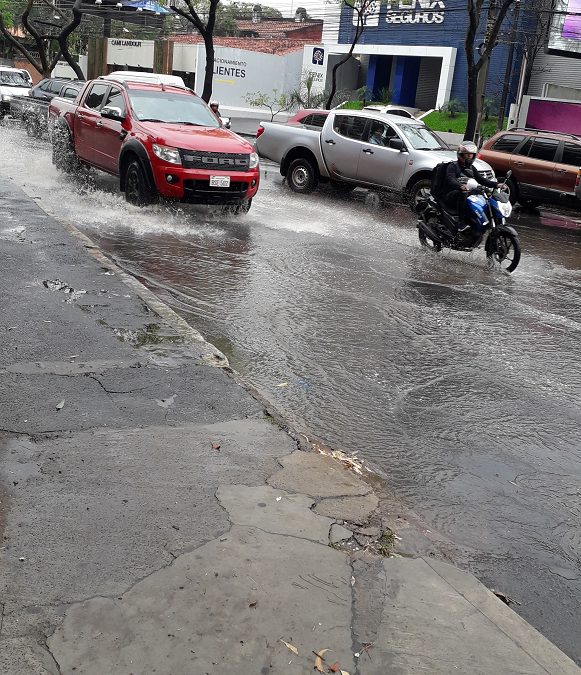In Paraguay for most of the year the sun shines brightly. It can though rain at any time during the year. When it does the rain comes down in torrents.
With bright clear skies being the normal state of affairs things are built to cope with that.
Most roads are built without drainage. That would be an expensive addition to the building costs and one that was rarely called into action. Things are a little different in Asuncion where storm drains have been built to take the excess water away.
Instead gravity is relied upon to take away the rain water. This way water is drained away to the lowest points. Often where a stream or river flows. However inevitably the volume of water is such that streets do flood.
During a storm this is not really a concern. The rains are so torrential that no one is in the streets unless they really have to be. Shop doorways fill with customers waiting for the rain to ease so that they may continue with their business. An umbrella is if no use if your ankles are underwater.
Once the heaviest of the rain has passed the water becomes more of an issue for the populace. The water always takes time to drain away.
Meanwhile the uneven pavements are full of deep puddles. Crossing a road is more like fording a swiftly flowing river. And water thrown up by passing vehicles quickly soaks pedestrians.
To keep the waters confined to the road and out of the surrounding buildings the roadside kerbs are high. Far higher than those in Europe. They do their job of confining the water, but where ramps have not been installed can prove quite a challenge to those no comfortable to high steps.
With such high kerbs a flooded river is deceptively deep. Stepping into one in a bid to reach the other side and one will quickly find feet disappearing beneath the waves.
Still worse is alighting from a bus during or after a storm. Buses tend to stop a distance from the kerb. Between it and the kerb there may be fast flowing water of an unknown depth to cross.
The streets do all for a while become rivers. However before too long the bulk of the water has flown away. Behind it may leave thick sticky mus and piles of leaves and rubbish but the streets do reappear to be reclaimed by the pedestrians.
Like everyone in Paraguay I have learnt not to try and battle the elements. Far better to stay off the streets until the storm is over and the water has drained away.
As for an umbrella. Little point in carrying one around. Rain in Paraguay tends to be all or nothing. So if there is enough to require an umbrella it will probably very shortly be too heavy for the umbrella to be of much use.
Storms of such intensity whilst they are a possibility at any time of the year it is equally possible one of such strength may not occur for months. Hence the lack of thought given to drainage when roads are being built.
Also weather has a strange effect on the mind. What it is like now so often seems like the only way it has ever been. So as it is generally sunny it is easy for both planners and public to overlook the likelihood of rain.
Furthermore a warm sun in a blue sky dries the land. Often no matter how fierce a storm has been the next day the ground will look as dry as ever. Just the occasional puddle here and there acting as a reminder as to how the weather had been the day before.
On final thing that I should mention about the water a heavy storm brings. Everything above is applicable only to the towns and cities. There are to be found pavements and tarmac roads. Much of Paraguay though is countryside without such things.
Where I live is fairly typical in that respect. Houses and homesteads strung out along a valley though which a dirt track runs.
Here water runs off the surrounding fields into the track. This through years of use has worn down to now be noticeably lower than the surrounding land.
As such when the rain water reaches the track it has nowhere further to go. This under a serious downpour quickly turns to deep mud.
I then have in effect a 5km long muddy ditch lying between me a solid tarmac. I am then cut of and isolated and unable to contact the outside world until the water soaks away and the track again solidifies.
This situation never lasts long. Within a day or two the ground has dried and hardened. Then just like in the towns there will be no clues beyond a few puddles to say that it had ever rained.


This is my first time pay a quick visit at here and i am really pleassant to read all at single place. Magdalen Esme Godred